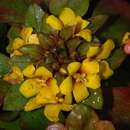Comments
provided by eFloras
Used for injuries, fractures, contusions, and strains.
- license
- cc-by-nc-sa-3.0
- copyright
- Missouri Botanical Garden, 4344 Shaw Boulevard, St. Louis, MO, 63110 USA
Description
provided by eFloras
Herbs perennial, 6--50 cm tall. Stems prostrate, rooting at nodes, upper part and branches ascending, fulvous pilose. Branches often with leaves only at apex. Leaves opposite, upper 2 pairs crowded; petiole 1/2--1/3 X as long as leaf blade, narrowly winged; leaf blade ovate to broadly ovate or suborbicular, (0.7--)1.4--3(--4.5) X (0.6--)1.3--2.2(--3) cm, with appressed articulate hairs, rarely glabrescent, reddish or black glandular punctate mainly near margin, base subrounded to short attenuate, apex acute to obtuse; veins 2--4 pairs; veinlets inconspicuous. Racemes terminal, abbreviated, capitate, 2--4-flowered, rarely with solitary flowers in axils of leaf pairs below inflorescences. Pedicel to 2 mm. Calyx lobes lanceolate, 5--8.5 X 1--1.5 mm, abaxially sparsely pubescent. Corolla yellow; tube 2--3 mm; lobes ovate-elliptic to oblong, 7--8 X 3--6.5 mm, sparsely dull red or black glandular punctate, abaxially dull red at base, apex acute to obtuse. Filaments connate basally into a ca. 2.5 mm high tube, free parts 2.5--4.5 mm; anthers oblong, dorsifixed, opening by lateral slits, ca. 1.5 mm. Ovary pubescent; style 5--7 mm. Capsule subglobose, 3--4 mm in diam. Fl. May-Jun. 2n = 48.
- license
- cc-by-nc-sa-3.0
- copyright
- Missouri Botanical Garden, 4344 Shaw Boulevard, St. Louis, MO, 63110 USA
Distribution
provided by eFloras
Himalaya (Nepal to Bhutan), Assam, Burma, N. Thailand, E. Tibet, China, Taiwan.
- license
- cc-by-nc-sa-3.0
- copyright
- Missouri Botanical Garden, 4344 Shaw Boulevard, St. Louis, MO, 63110 USA
Distribution
provided by eFloras
Anhui, Fujian, S Gansu, Guangdong, Guangxi, Guizhou, Hainan, Hubei, Hunan, Jiangsu, Jiangxi, Qinghai, S Shaanxi, Sichuan, Taiwan, Xizang, Yunnan, Zhejiang [Bhutan, NE India, Myanmar, Nepal, Sikkim, Thailand, Vietnam]
- license
- cc-by-nc-sa-3.0
- copyright
- Missouri Botanical Garden, 4344 Shaw Boulevard, St. Louis, MO, 63110 USA
Elevation Range
provided by eFloras
1600-2100 m
- license
- cc-by-nc-sa-3.0
- copyright
- Missouri Botanical Garden, 4344 Shaw Boulevard, St. Louis, MO, 63110 USA
Habitat
provided by eFloras
Ditches, roadsides, banks of rice paddies, damp forest margins; 200--1200 m.
- license
- cc-by-nc-sa-3.0
- copyright
- Missouri Botanical Garden, 4344 Shaw Boulevard, St. Louis, MO, 63110 USA
Synonym
provided by eFloras
Lysimachia congestiflora Hemsley var. atronervata C. C. Wu; L. gymnocephala Handel-Mazzetti; L. hui Diels ex Handel-Mazzetti; L. japonica Thunberg var. cephalantha Franchet; L. nigropunctata Masamune; L. rubroglandulosa C. Y. Wu; L. smithiana Craib; L. taiwaniana Suzuki ex M. T. Kao.
- license
- cc-by-nc-sa-3.0
- copyright
- Missouri Botanical Garden, 4344 Shaw Boulevard, St. Louis, MO, 63110 USA
Lysimachia congestiflora
provided by wikipedia EN
Lysimachia congestiflora, known as golden globes loosestrife or creeping Jenny, is a flowering plant species in the primrose family that native to southeast Asia.
Description
It is an aboveground perennial and a herbaceous, stolon-former plant that reaches heights of 10 to 20 cm. The stem is creeping to ascending and forms knots at the roots.
The leaves are opposite. There are two pairs of leaves just below the inflorescence. The leaf blade measures (0.7) 1.4 to 3 (4.5) × (0.6) 1.3 to 2.2 (3) centimetres and is ovate to broadly ovate or almost circular. It has pressed, articulated hair, and mainly has reddish or black glandular points on the edge.
Inflorescences
The flowers are heaped upside down at the end of the stem in two to four. The flowers are colored yellow with a red eye. The ovary is hairy. The flowering period extends from spring to summer.[1]
Distribution
It occurs in China, Bhutan, northeast India, Nepal, Sikkim, Myanmar and Thailand in moist forest edges, bushes and the edges of rice fields at altitudes of 200 to 2100 meters.
Cultivation

'Outback Sunset' cultivar
It is grown as an ornamental plant for its bright yellow flowers and easy maintenance, in moist well-drained soils, thriving in full sun to partial shade. It can be grown from stem cuttings. Cultivars include:[2]
- ‘Aurea’
- 'Outback Sunset' (variegated leaves)
- ‘Persian Chocolate’ (purplish foliage)
- 'Waikiki Sunset' (variegated leaves)
- ‘Zimai’ (purple-veined leaves)
Chemistry
Lysimachia congestiflora yields the O-methylated flavonol syringetin.[3]
References
-
^ Eckehart J. Jäger, Friedrich Ebel, Peter Hanelt, Gerd K. Müller (eds.): Rothmaler excursion flora from Germany. Volume 5: Herbaceous ornamental and useful plants . Spectrum Academic Publishing House, Berlin Heidelberg 2008, ISBN 978-3-8274-0918-8 .
-
^ Lysimachia congestiflora by NC State Extension
-
^ Flavonol glycosides from Lysimachia congestiflora. Jian Guo, , Dong-Lei Yu, Lizhen Xu, Min Zhu and Shi-Lin Yang, Phytochemistry, Volume 48, Issue 8, August 1998, Pages 1445-1447

- license
- cc-by-sa-3.0
- copyright
- Wikipedia authors and editors
Lysimachia congestiflora: Brief Summary
provided by wikipedia EN
Lysimachia congestiflora, known as golden globes loosestrife or creeping Jenny, is a flowering plant species in the primrose family that native to southeast Asia.
- license
- cc-by-sa-3.0
- copyright
- Wikipedia authors and editors

